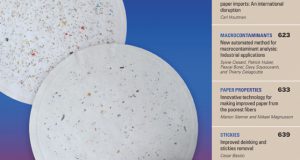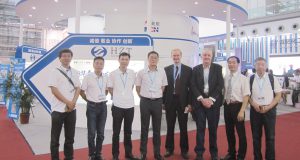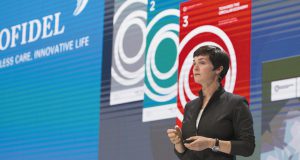Having made premium grades for popular branded products for decades, in what new ways can a mill further optimize to stay ahead?
That was the question management asked itself at Reno de Medici Ovaro, which produces a wide range of cartonboard grades and is part of the RDM Group (see sidebar.)
“Creativity must always be in the air,” says Giorgis Silvano, president at RDM Ovaro. “Packages made from our cartonboard must meet exacting standards for quality and performance from the world’s brand leaders. In fact, those standards change all the time. The RDM Ovaro team has a track record for adapting in an efficient way.”
According to Adriano Micoli, mechanical and thermal plants manager at RDM Ovaro, “Our style gives operators the freedom to use their know-how and time efficiently. We are always aiming for even greater stability and predictability of production.”
 In 2016, the mill contracted for a comprehensive drying survey. “To progress to the next level, it helps to know exactly where you are,” Micoli says. “The findings from the drying survey provided a blueprint to implement a phased plan to reduce off-quality paper around sheet breaks, primarily by stabilizing the dryer temperatures more rapidly.”
In 2016, the mill contracted for a comprehensive drying survey. “To progress to the next level, it helps to know exactly where you are,” Micoli says. “The findings from the drying survey provided a blueprint to implement a phased plan to reduce off-quality paper around sheet breaks, primarily by stabilizing the dryer temperatures more rapidly.”
The mill developed the project plan with Kadant, the supplier that had performed the drying survey. “The top goal of the modification was steam savings. This target made it possible to justify the investment to the board of directors based on an ROI of less than one year—which we accomplished,” says Micoli.
based on an ROI of less than one year—which we accomplished,” says Micoli.
Elia Primus, technical department leader at RDM Ovaro, noticed improvements early in the project: “Phase One, which included steam and condensate system components as well as steam joints and stationary syphons for the dryers, has already boosted sheet quality and helped speed up the machine due in large part to less frequent sheet breaks.”
The PM1 survey, done in March, 2016, identified several crucial areas for improvement, including:
• High energy losses to the water condenser 1.2 t/h
• Control difficulties
• Lack of flexibility (no vacuum at the low pressure separator)
“The survey data was useful to perform a ‘Can-by-Can’ calculation, which identified the achievable targets from a proper steam and condensate system rebuild,” says Primus.
IMPROVING THE PRE-DRYER SECTION AND VACUUM SYSTEM
 RDM Ovaro initially focused on improving a recurring issue that appeared at the pre-dryer section and the vacuum system. As Primus explains, “a system-wide thermal regrouping, combined with individual controls at the wet end dryers, gave the machine the ability to achieve the required drying strategy to guarantee sheet quality and reduce steam losses to the condenser.”
RDM Ovaro initially focused on improving a recurring issue that appeared at the pre-dryer section and the vacuum system. As Primus explains, “a system-wide thermal regrouping, combined with individual controls at the wet end dryers, gave the machine the ability to achieve the required drying strategy to guarantee sheet quality and reduce steam losses to the condenser.”
The first part of the machine was equipped with new rotary joints and modern, internally-supported stationary syphons. The vacuum system was totally revamped, reducing the number of dryers connected to the condenser, and installing differential pressure controls. Benefits for this part of the project include:
• Drying capacity increased by 2.3 percent
• Energy saving: 3.3 percent reduction in steam use
• Improved machine flexibility when producing low basis weights
“A thorough machine survey is a strategic tool for a successful business,” says Graziono Buttiglione, Kadant. “This approach establishes a special link between machine operators and our systems engineers. We spend four days taking measurements, but best of all, we talk with the team to understand the pains, the requirements, and the wishes.
“Following the machine survey, we develop a comprehensive and detailed report with highlights of the measurements analysis and machine improvement points. Together, we move ahead with a solid plan.”
A CLEAR PATH
Primus and Micoli point out that operators used to make adjustments during every shift without the benefit of systematic control. Now, it’s much easier to get the machine up and running, rather than making on-the-spot adjustments.
Smooth operation between shifts was always challenging. There was always inconsistent pressure management during low production rate runs, as well as variable management of dryers during sheet break and start-ups. Kadant stressed the importance of making a range of modifications to the paper machine critical to achieving desired results.

 The RDM Ovaro team set clear goals prior to the retrofit. They included a production increase, reduced sheet break recovery time, increased reliability of equipment, and minimization of steam and energy usage. Early on it was evident that better control was needed.
The RDM Ovaro team set clear goals prior to the retrofit. They included a production increase, reduced sheet break recovery time, increased reliability of equipment, and minimization of steam and energy usage. Early on it was evident that better control was needed.
Says Micoli, “The production team needed a better way to monitor and track differential pressures to calculate set points. Without an accurate way to determine condensate load, there was no easy way to know what differential load was best for us on a grade-by-grade basis. Uncontrolled differential pressure caused reliability problems, as well as wasted steam. Often, steam went to a condenser and then back to the powerhouse instead of being used for drying paper.”
BASIC CHANGES TO IMPROVE CONSISTENCY
Phase One of the project included installing individual pressure and differential pressure controls at the early dryers. This move alone allowed operators to better control the temperature ramp of the paper, improving the quality and minimizing energy losses. Kadant designed the new control logic, which was implemented by RDM programmers. This included operator training.
“RDM Ovaro’s ability to minimize time and waste associated with breaks is the heart of their success,” says Buttiglione. “Plus, there are many other benefits, including making grade changes more efficiently and opening the door for further energy savings.”
Now, optimum set points provide proper drying conditions, efficient energy use, and guarding against dryer flooding. Improved productivity, consistency of operation, operator ease of use, and low steam consumption are some of the benefits.
 “Minimal time lost during sheet breaks and cull losses around breaks are obvious to all. In addition, time saved every day equals more quality output, allowing operators to do troubleshooting and preventive maintenance,” says Primus.
“Minimal time lost during sheet breaks and cull losses around breaks are obvious to all. In addition, time saved every day equals more quality output, allowing operators to do troubleshooting and preventive maintenance,” says Primus.
In addition to the hardware, software, and implementation issues, “operators have received training related to steam and condensate methodology improvements and can apply their new knowledge to achieve higher reliability of the paper machine,” he adds.
apply their new knowledge to achieve higher reliability of the paper machine,” he adds.
Continues Micoli, “Our mill is also constantly optimizing formulations. As we reduce variability, we are able to tighten specifications. Less variability means more profitability. It’s only normal from operator to operator to see a lot of variability. But with Kadant’s help, we have found our groove for the range of grades as the maximum output. We run full-out on steam without our customers seeing linting and picking.”
LOOKING AHEAD
The project’s second phase, scheduled for late 2017, will improve runnability from the after-dryer section to the after-coater. The mill is also considering plans to close the loop on moisture control.
“In addition to implementing the second step in 2017 on PM1, we are also intending to complete a drying survey for PM2, trying to identify the potential for similar improvements,” adds Buttiglione.
Reliability, less variability, fewer breaks, rapid recovery, and energy savings. What else matters to boost first quality production? Just ask the RDM Ovaro team, because they will have a long list every Monday morning.
Elia Primus, RDM Ovaro technical department; and Adriano Micoli, mechanical and thermal plants manager, beside the steam and condensate system. They report much more visibility and easier troubleshooting after the new controls were implemented.
Primus says that when you are “in the fog” beside the dryers, you know things are working right. It’s just one visible way to sense correct performance.
Because the mill supplies cartonboard for brand leaders, Ovaro’s products must meet exacting standards for quality and performance.
Papermaking Heritage and Natural Beauty in the Italian Alps
RDM Ovaro is nestled in Friuli, the northernmost region of Italy, where much of the territory is protected by strict landscape and environmental laws. With the mountains Col Gentile and Arvenis to the east, and Monte Volaia to the north, acclaimed ski resorts and hiking trails are nearby.
With origins in 1933, the existing fine paper mill was converted to board production in 1952. In 1970, upgrades were made to produce high-end coated and uncoated cartonboard for premium brand packaging and hardback book covers. Now, only recycled furnish is used.
Beginning in 2017, Reno de Medici, Cascades La Rochette, and Careo have been unified as RDM. The first step toward the new identity came in 2008, with the strategic business combination between Cascades Europe and Reno de Medici, as well as the creation of Careo. This integration was finalized in June 2016 with the contribution of the La Rochette mill. RDM is a multinational organization with six cartonboard production facilities in Europe. With products sold in more than 70 different countries around the world, RDM employs more than 1,500 people. The RDM Group is the leading Italian, and second-ranked European, producer of cartonboard based on recycled material mills in Italy, Spain, France, and Germany.
Elia Primus, RDM Ovaro technical department; and Adriano Micoli, mechanical and thermal plants manager, enjoy the view of the
Italian Alps outside the mill.
Scope of
the project
• Steam and condensate system design and rebuild
• Installation supervision
• Start-up and commissioning assistance
• Components for steam and condensate systems
• Rotary steam joints and stationary syphons
• Training of operators
With new dryer control logic accessed through their existing DCS, operators have more time to see trends and problems.
Production Manager Stefani Alvise, with Micoli and Primus, after project completion.
With a production capacity of 110,000 mtpy, RDM Ovaro ships a range of cartonboard grades from its picturesque location in Northern Italy.
From left: Adriano Micoli, mechanical and thermal plants manager, and Elia Primus, technical department.
 Paper 360
Paper 360


